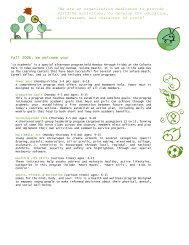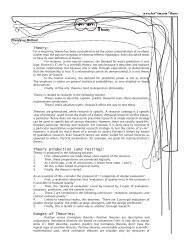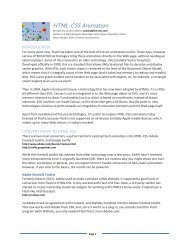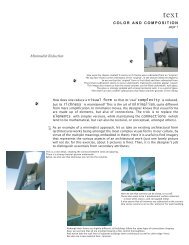ULTRAPERFORMING Beams/ Columns Doors ... - fen-om data
ULTRAPERFORMING Beams/ Columns Doors ... - fen-om data
ULTRAPERFORMING Beams/ Columns Doors ... - fen-om data
Create successful ePaper yourself
Turn your PDF publications into a flip-book with our unique Google optimized e-Paper software.
Insulating Wood-Cement Forms<br />
Faswall wall-forms are used as the forms for poured concrete walls, yet left in place to provide<br />
permanent insulation around concrete structures as well as a durable surface to apply whatever<br />
surface finish is desired. No additional insulation, exterior sheathing, bracing or “wrap” is<br />
needed. Not only are material costs reduced, but labor costs for installation are eliminated as<br />
well. This system allows almost any fibrous material, including waste woods, green timber, and<br />
even agricultural by-products to be successfully c<strong>om</strong>bined with cement into strong and durable<br />
products. Instead of wasting space in landfills, waste wood can now be recycled efficiently<br />
and inexpensively into a strong, durable building system. The K-X system uses a two-stage<br />
mineralization process to preserve the wood. The ionization between the wood fibers and the<br />
K-X minerals makes a permanent chemical bond that allows the fibers to bec<strong>om</strong>e an integral part<br />
of the concrete, not just be coated by it. Faswall forms are unlike other blocks made of foamed<br />
plastic, and will not burn, rot, or allow vermin and insects to invade. The forms are made out of<br />
85% K-X Aggregate (treated recycled woodchips) and 15% portland cement. Fly ash can replace<br />
3% cement if desired.<br />
www.faswall.c<strong>om</strong><br />
Kirei Board<br />
Kirei board is a new environmentally friendly building material c<strong>om</strong>posed of 100% recycled<br />
agricultural fiber. Strong and lightweight, Kirei board has nearly unlimited uses in contemporary<br />
design. Manufactured fr<strong>om</strong> recycled sorghum stalks and the formaldehyde-free KR Bond adhesive,<br />
Kirei board helps to reduce landfill waste and eliminate harmful Volatile Organic C<strong>om</strong>pounds in<br />
the ambient airspace. Sorghum, the principal c<strong>om</strong>ponent of Kirei board, is a drought-tolerant food<br />
grain requiring little fertilizer or pesticides to grow. Now, through a revolutionary process, these<br />
previously discarded stalks provide the foundation for a strong, delicately grained, lightweight<br />
building material. Ideal uses for Kirei board include: interior architectural surfacing, cabinetry,<br />
furniture, paneling, display fixturing, interior wall coverings, office dividers, h<strong>om</strong>e decoration,<br />
and finished roducts & accessories.<br />
www.kireiusa.c<strong>om</strong><br />
Lignasil Tile<br />
Madera solid surface tile is made entirely fr<strong>om</strong> Lignasil, which is a high performance bioc<strong>om</strong>posite<br />
material made fr<strong>om</strong> recycled natural fibers. The integral-color tile is designed for high<br />
traffic applications, and is less expensive, lighter-weight, and warmer to the touch than ceramics<br />
or stone. Standard Madera tiles are precision molded to 12” x 12” x 3/8”, but can be cut easily<br />
with typical woodworking tools.<br />
Liquid Wood<br />
Renewable raw materials ease the burden on the environment. Researchers fr<strong>om</strong> the Fraunhofer<br />
Institute for Chemical Technology ICT in Pfinztal near Karlsruhe, led by Prof. Peter Eyerer and<br />
Dr. Norbert Eisenreich, are developing a thermoplastic material – deformable under heat – based<br />
on natural resources. The unusual thing about this material, which is known as Arboform is<br />
that although it possesses similar properties to wood, it can be cheaply injection- molded like a<br />
plastic. This can be a major advantage in production, for example, in the manufacture of molded<br />
parts for the aut<strong>om</strong>obile industry. One of the raw materials used in Arboform is lignin. This is the<br />
substance that gives wood its rigidity. Lignin is the second most frequently occurring polymer in<br />
nature. Every year millions of tons of it are produced as a by-product in the paper industry. Up<br />
to now lignin has mainly been burned in order to produce energy, but this renewable material<br />
can also be used in a different way: when lignin is mixed with natural fibers, the thermoplastic<br />
material Arboform is formed. This can be used in many applications as a substitute for synthetic<br />
materials derived fr<strong>om</strong> oil. “We have been working for two years on the optimum c<strong>om</strong>position<br />
of natural polymers and natural fibers,” Helmut Nägele and Jürgen Pfitzer of the ICT report. The<br />
scientists are working on ways of making Arboform more malleable and more heat-resistant.<br />
liteCORE<br />
When architects Christian Mitman and Emmanuelle Bourlier were unable to find a lightweight,<br />
translucent material for a project they were working on, they halted their search and took a<br />
different approach to solving the problem: they invented one. Hence the birth of liteCORE,<br />
translucent honeyc<strong>om</strong>b panels that are not only perfect for sliding walls, screens and tables, but<br />
this sleek material is also sturdy enough to be used for a ceiling or a floor. With such demand<br />
for the panels (both residential and c<strong>om</strong>mercial,) Mitman and Bourlier’s c<strong>om</strong>pany has expanded








